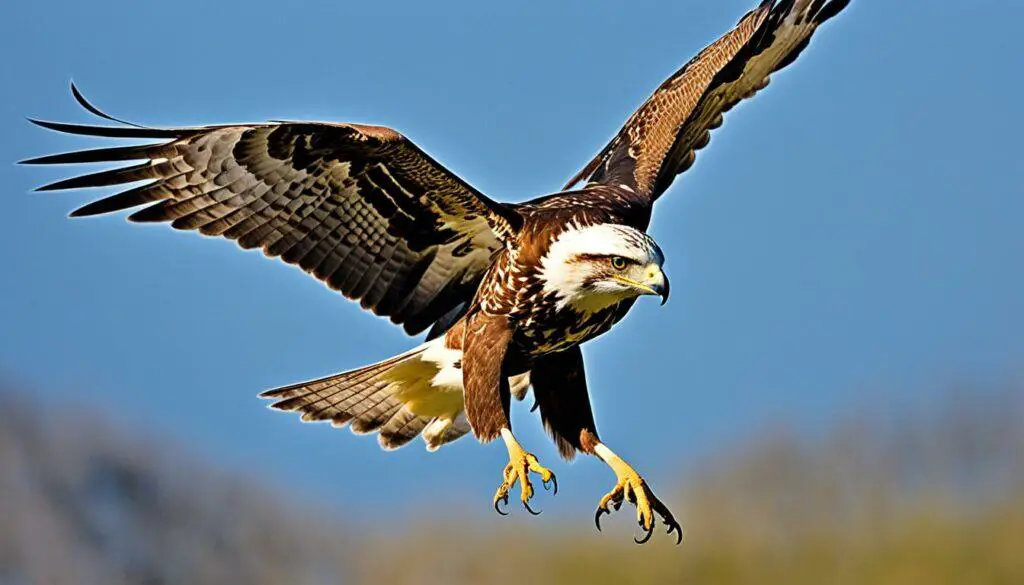Have you ever seen a big bird in the sky and wondered if it’s a hawk or eagle? It’s fun to figure out which one it is.
Both hawks and eagles are great hunters with sharp vision and tools. But they are different in size, how they fly, and what they look like. Knowing these details helps us tell them apart.
Eagles are usually bigger with wider wings. They often fly with their wings flat. Hawks, on the other hand, may show a V shape in the air. This is called a dihedral wing position. In places like Colorado, look for Bald Eagles with their white heads and tails. They’re different from Golden Eagles, which are darker.
Can you tell if it’s a hawk or eagle the next time you see one flying?
Introduction to Raptors: Hawks and Eagles
Raptors include eagles and hawks, known for their great hunting and unique parts. They have amazing eyesight, hooked beaks, and strong talons. When we look at hawk vs eagle, they are related and often seen flying up high. They use warm air currents to save energy while hunting.
Although similar in the way they fly, hawks and eagles are quite different in size and shape. This makes raptor identification easier. For example, Bald Eagles and Golden Eagles stand out because of their specific colors and behaviors.
Watching them fly can show you their unique skills and helps in raptor identification. Knowing these details makes telling these amazing birds of prey apart simple.
Understanding the Family Accipitridae
The Accipitridae family is filled with many different kinds of raptors. Knowing about them is key to understanding this group. Hawks and eagles are part of it, and they show us the hawk and eagle differences. These are important for recognizing and learning about them.
Hawks are split into groups like Accipitrinae and Buteoninae. Accipitrinae hawks are very nimble and excel at hunting other birds. But Buteoninae hawks are stronger and bigger. They typically hunt mammals. This shows how they’ve adapted in the Accipitridae family.
Eagles have their own unique groups. These include fish eagles, snake eagles, giant forest eagles, and booted eagles. Each group prefers certain types of food and lives in different places. This helps them survive and thrive as top predators. Learning about these groups gives us a better view of raptor taxonomy. It makes recognizing these powerful birds more accurate.
- Accipitrinae Hawks: Agile and bird predators.
- Buteoninae Hawks: Robust and predominantly mammal hunters.
- Fish Eagles: Masters of aquatic prey.
- Snake Eagles: Specialized in hunting reptiles.
- Giant Forest Eagles: Adapted to dense forest environments.
- Booted Eagles: Versatile with a broad prey spectrum and adapted to various habitats.
Understanding the differences between hawks and eagles is crucial. It helps enrich our knowledge of raptor taxonomy. This makes it easier to identify different species in the Accipitridae family.
| Type | Primary Prey | Habitat |
|---|---|---|
| Accipitrinae Hawks | Other Birds | Forests and Woodlands |
| Buteoninae Hawks | Mammals | Open Fields and Grasslands |
| Fish Eagles | Fish | Near Water Bodies |
| Snake Eagles | Reptiles | Open and Arid Areas |
| Giant Forest Eagles | Large Mammals and Birds | Dense Forests |
| Booted Eagles | Versatile Diet | Various Habitats |
Key Size Differences
In telling hawks and eagles apart, size is key. Eagles are usually bigger and more impressive than hawks. Knowing this helps in identifying these birds of prey.
Size Comparison
The Ferruginous Hawk in North America is the biggest hawk. Despite being large, it’s close in size to some smaller eagles. Knowing this helps us tell eagles apart from hawks.
Wingspan Differences
Eagles often have bigger wingspans than hawks. For example, in Illinois, hawks’ wingspans can be 20 to 60 inches. But eagles’ wingspans are much bigger, from 44 to 110 inches. This big wingspan difference is a major clue to identifying eagles and hawks.
Color and Marking Patterns
Eagles and hawks have unique color and marking patterns that help tell them apart. Usually, eagle plumage looks the same all over. In contrast, hawk color patterns show more variety.
Color Variations
Bald Eagles stand out with their white heads and tails against dark brown bodies. Golden Eagles, on the other hand, are mostly dark brown with a golden nape. These clear differences in eagle plumage make them easy to spot.
Red-tailed Hawks, for example, are lighter underneath with a red tail. They are easily recognizable from other hawks. Some hawks have darker belly bands, adding to the variety in hawk color patterns.
Notable Wing and Tail Markings
Raptors have special identification markings on their wings and tails. Golden Eagles might have bars or spots on their wings. Bald Eagles show a white tail, especially as adults. These raptor identification markings are key for bird watchers.
Red-tailed Hawks have broad tails and showy red feathers when flying. Extra markings, like a belly band, help identify hawk species. These unique raptor identification markings are vital for bird enthusiasts and scientists.
Habitat Preferences of Hawks and Eagles
Understanding where hawks and eagles like to live can help us recognize them. These large, powerful birds choose habitats that help them hunt efficiently and find food.
Eagles, including Bald Eagles, love places near water. They often perch in tall trees or on cliffs facing bodies of water. This gives them easy access to their main food, fish.
Hawks, on the other hand, can be found in a variety of places. Many enjoy living in forests, using the trees for cover when hunting and building nests. The Red-tailed Hawk, for instance, likes open fields or woodland edges. These spots offer a clear view of their prey.
This shows how each raptor uses its environment in its unique way. Their differences tell us a lot about them.
Comparing Raptor Habitats:
| Bird of Prey | Preferred Habitat | Key Features |
|---|---|---|
| Bald Eagle | Near Bodies of Water | Fishing Ability, Tall Perches |
| Red-tailed Hawk | Forests and Open Fields | Adaptability, Diverse Diet |
Knowing about these different raptor habitats can help you tell hawks and eagles apart. Paying attention to the surroundings is key in identifying them correctly.
Flight Characteristics
It’s key to know how hawks and eagles fly to spot them correctly. They have different wing shapes and ways of soaring. These traits show the raptors’ hunting methods and where they live.
Wing Shape and Soaring Behavior
Eagles have big, flat wings, making their flight steady. They soar like a plane, staying level easily. Meanwhile, hawks use their rounded wings to soar in a V shape. This helps them turn quickly when hunting.
Observed Flight Patterns
How raptors fly also helps with identification. Raptor flight behavior differs. Eagles fly steadily with sharp, visible feathers. In contrast, soaring raptors like hawks have a more spread-out wing shape.
| Characteristic | Hawks | Eagles |
|---|---|---|
| Wing Shape | Rounder | Straight-edged |
| Soaring Behavior | Dihedral | Level, stable |
| Flight Pattern | More maneuverable | Glide effortlessly |
Watching hawk flying patterns and how eagles fly helps us understand and spot them better.
Types of Prey and Hunting Techniques
Understanding what raptor prey they like and hunting techniques helps us tell hawks and eagles apart. Eagles go for big prey thanks to their large size and strength. They might catch baby mountain goats, using their sharp talons and beaks.
Hawks, though, have a wider menu, hunting smaller animals like mice, lizards, and tiny birds. They make quick and accurate strikes thanks to their flexible bodies. These different methods show how each bird meets its food needs in special ways.

| Raptor | Preferred Prey | Hunting Technique |
|---|---|---|
| Eagle | Larger vertebrates (e.g., mountain goats) | Utilizes strength and powerful talons to capture and kill |
| Hawk | Smaller vertebrates (e.g., rodents, reptiles) | Employs speed and agility for swift strikes |
Knowing about raptor prey and hunting techniques is key to understanding and valuing bird diversity. It offers insights into why these birds are important in nature.
Distinguishing Features During Maturity
Raptors change a lot as they grow up, especially in their looks. This makes telling different kinds of raptors apart a big deal.
Juvenile vs. Adult Appearance
Juvenile hawks look quite different from adult eagles. They are usually lighter in color. As they grow up, their colors get darker and more vivid. Juvenile Red-tailed Hawks don’t have the classic red tail; it’s a mix of other colors instead.
As eagles get older, they get more vibrant and stand out. For instance, a Bald Eagle starts showing white on its head and tail. But, when they’re young, they are mostly brown. The Golden Eagle, over time, shows a brighter, golden part on its neck against the darker colors.
| Species | Juvenile Appearance | Adult Appearance |
|---|---|---|
| Red-tailed Hawk | Pale, mottled, banded tail | Reddish tail, darker plumage |
| Bald Eagle | Brownish, lack of white head and tail | White head and tail, dark brown body |
| Golden Eagle | Browner, less pronounced golden nape | Darker plumage, prominent golden nape |
Knowing these changes helps in spotting different raptors. It’s key in recognizing a young hawk from an old eagle.
Differentiation by Sound
Listening to raptors can help you learn about these great birds. Many think eagle calls would be loud, matching their size. But, eagle calls are actually pretty high-pitched and not loud at all. Now, hawk sounds are much sharper and louder, making a stark raptor vocalizations difference.
Recognizing these sounds is key to telling them apart. For example, a Bald Eagle surprises with soft, small chirps. This isn’t the noise you’d think such a big bird would make. On the flip side, the Red-tailed Hawk has a strong, loud screech. This can give the impression they’re much bigger because of their call.
Here’s a helpful comparison:
| Bird | Call Type | Sound Characteristics |
|---|---|---|
| Bald Eagle | Chirps | High-pitched, almost whistling |
| Golden Eagle | Chirps | Short, clear notes |
| Red-tailed Hawk | Screech | Loud, rasping scream |
| Cooper’s Hawk | Cackles | Rapid, repetitive “kik-kik-kik” |
This understanding of eagle calls and hawk sounds boosts your bird spotting skills. It also adds to the joy of seeing these amazing creatures in the wild.
Regional Variations: Hawks and Eagles in the United States
Regional differences are key in how hawks and eagles are seen and act in the U.S. This is mainly due to various climates, plants, and animals in each area. It’s vital to know these factors to identify local raptors correctly.
In Illinois, there are eight kinds of hawks and two types of eagles. Size matters a lot when telling them apart. They adapt based on what food is available and where they can build their nests.
Knowing these regional details helps spot hawks and eagles for anyone. It’s useful whether you’re a bird enthusiast or just like watching them. This understanding adds to the wonder of these amazing birds in the U.S.
FAQ
How do you distinguish between a hawk and an eagle?
Eagles are bigger than hawks and have longer wings. They show bright colors like Bald Eagles. Hawks have rounder wings and a unique soaring style.
What are the key characteristics of raptors like hawks and eagles?
Raptors like hawks and eagles have sharp vision, curved beaks, and strong feet. They are skilled hunters and use the wind to fly without much effort.
How do size and wingspan vary between hawks and eagles?
Eagles are larger and have wider wings than hawks. Hawks are usually smaller, with shorter wings. The largest hawk can match some of the smaller eagle species.
What are some notable color and marking patterns on hawks and eagles?
Bald Eagles have white heads and tails with dark bodies, standing out. Golden Eagles are dark on top with a golden area on their neck. Red-tailed Hawks have light bellies and a red tail.
What habitats do hawks and eagles prefer?
Eagles live near water to catch fish. Hawks might be found in forests or open areas. Where they live gives hints to their type.
How do hawks and eagles differ in flight characteristics?
Eagles fly with steady wings, while hawks often soar with a tilt. Their distinctive flying styles help tell them apart.
What types of prey do hawks and eagles hunt?
Eagles go after larger animals, like baby mountain goats for Golden Eagles. Hawks chase down small animals because of their speed and maneuverability.
How do hawks and eagles change in appearance as they mature?
Youth hawks and eagles look different from adults. Knowing these changes can help identify their age and species.
How can vocalizations help in identifying hawks and eagles?
Stars have high-pitched calls, and hawks have hoarse sounds. Knowing their calls is part of recognizing these birds.
Are there regional differences in hawk and eagle species across the United States?
Yes, different places offer unique hawk and eagle types and behaviors. Illinois, for example, has a varied raptor population. Understanding these changes is key to identifying them.







